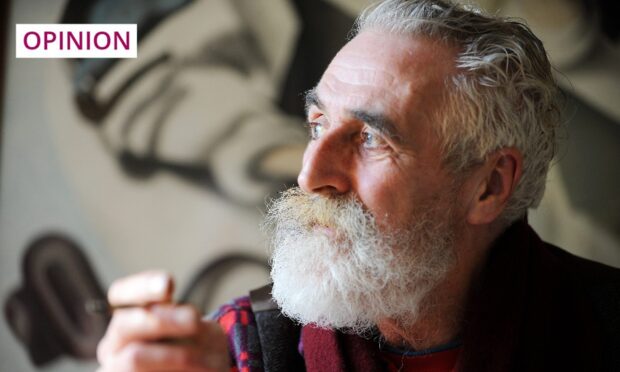John Byrne died two weeks ago today, and what more can there be left to say about him?
He left us, aged 83, on the same day as beloved Pogues frontman Shane MacGowan and former chancellor Alastair Darling. But there were no BBC breaking news push notifications about Byrne.
Word of the writer and artist’s death quietly arrived later, via an unassuming message on The Fine Art Society gallery’s website. Nonetheless, the sad update spread quickly on Scottish corners of social media. There’s no question that 83 is a decent innings, yet most reactions to the news were shocked and bereft.
A true culture icon, John Byrne didn’t just contribute to Scotland’s creative landscape in a big way during his lifetime, but immersed himself in the arts here. After his death, memories flooded social media: chatting with Byrne at a gallery, spotting him on the train, passing him – dressed dapper, as always – walking a rainy street.
It seems virtually everybody has their own tale of crossing paths with him, however briefly, myself included. He was indisputably present and often doing the same mundane things as you and me, albeit with above average elegance.
Byrne became synonymous with his striking self-portraits, to the extent that I think a lot of us could easily believe he straddled both real and painted planes of existence simultaneously – leaping out from the canvas to attend events or do interviews, then stepping back through the frame to rest. This theory would explain the number of times he seemed to appear from nowhere at his own Kelvingrove exhibition in 2022, to the great delight of visitors.
Despite aging before our eyes, Byrne had grown immortal in many minds – his omnipresence and quirky, timeless style helping to transform him into more myth than man. But man he was. And, as posthumous tributes began to appear online, Byrne’s humanity was their running theme.
‘Quiet words of encouragement’
For a start, it would appear the guy made time over the years to be interviewed by each young Scottish journalist whippersnapper who asked. (He deserved an award for that alone, in my view.) And, by all accounts, he was kind to every single one of us.
I was particularly moved by photographer Alex Boyd’s story of a chance meeting with Byrne on a train. Boyd was a student at the time, clutching a camera, and Byrne agreed to have his photograph taken on the station platform.
“With a few quiet words of encouragement, he told me to keep at it,” Boyd recounted. In the black and white picture he took of John Byrne, you can see the unmistakable warmth in his eyes.
I wish I could find the original of this picture – but many years ago I met John Byrne on the train from Edinburgh to Glasgow. I was shy, and he exuded style and effortless cool. Having read The Slab Boys at school and admiring his painting, I eventually said hello. 1/4 pic.twitter.com/MoQEZIV5RM
— Alex Boyd (@AlexBoyd) December 2, 2023
I shared a photograph of Byrne online after his death, too. I didn’t take it – he did. Years ago now, we emailed back and forth for a feature I was writing about his work. I asked him for a recent photo and he snapped a selfie.
He’s wearing a paint-splattered, dark blue work shirt and his grey curls are charmingly tousled. In the background, the walls are covered in framed artwork – his portrait of actor Peter Capaldi is the most easily recognised.
With hindsight and a little more worldly experience under my belt, two things strike me as remarkable about this encounter. The first is the lack of any gatekeepers. He was in his 70s by that point, and had been hugely successful and famous since before I was born. Yet, I emailed John Byrne and John Byrne’s people didn’t reply; John Byrne did, over and over again, until I had everything I needed.
Byrne’s work made art feel attainable
The second remarkable thing is that photo, taken – I can only assume – in his studio, or perhaps at his kitchen table. On one hand, a quick snap to appease a young Scottish journalist whippersnapper with no photographer; on the other, a one-of-a-kind self-portrait from an artist renowned for his astonishing self-portraiture (though, admittedly, not in his usual medium).
He could have told me to take a hike. He could have told me to use one of countless photos the paper already had on file. Instead, he just helped me out. Quiet encouragement in action.
I was asking him questions about Tutti Frutti, by the way – the 1987 TV series Byrne wrote for the BBC that I love but haven’t left myself any room to write about here. Watching it for the first time (more than 20 years after broadcast), I relished recognising Glasgow and hearing genuine Scottish accents.
The concurrent familiar grit and desirable glamour of Tutti Frutti, of all of John Byrne’s work, and even of Byrne himself, made art feel attainable; more everyday than ever, in the best way possible. The way he reminded Scotland that creativity, beauty and inspiration are everywhere, available for everybody, is his legacy. And the way he gave a leg-up to so many of us along the way will never be forgotten.
Alex Watson is Head of Comment for The Press and Journal and, sadly, not a gifted artist



Conversation